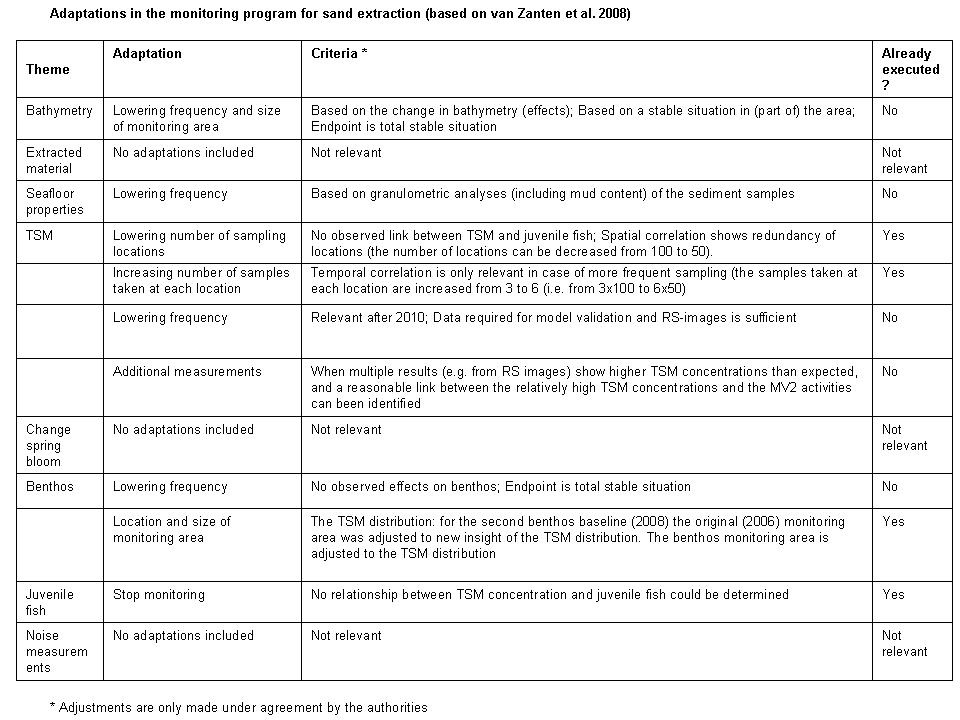Construction
In the construction phase, several aspects were important:
- baseline monitoring
- adaptive monitoring during execution
- structural evaluation of the MEP and legislative requirements
Baseline monitoring
In April 2006, the first baseline monitoring study started (Vertegaal et al. 2007). Baseline studies have been conducted for all elements of the monitoring plan.
Adaptive monitoring strategies in the monitoring plan of MV2
The extensive monitoring program of MV2 already includes several adaptive strategies, as discussed below. The adaptations are, however, related to the monitoring itself, rather than to the extraction operations.
The construction of Maasvlakte 2 is a huge project conducted over many years. The complete project is to be finalised in 2033. The first construction phase, from 2008 to 2013, requires 240 million m³ of sand. The current MEP (van Zanten et al., 2008) focuses on this first phase of the project, because the main effects are expected in this phase. For the second phase (after 2013), the MEP will be updated based on results from phase 1, including the lessons learned. Before implementation of the new MEP, it will be submitted to the authorities for approval.
Considering adaptive monitoring strategies, there are two types of evaluation that can be distinguished: structural evaluation of the entire MEP and evaluation of results within themes.
Structural evaluation of the entire MEP
The MEPs are evaluated every five years and, if needed, plans will be adjusted. The set-up of the MEP (van Zanten et al., 2008), however, does not refer to such a structural evaluation of the entire MEP, it only includes a periodic evaluation of monitoring plans per theme.
The establishment of a separate working group for the monitoring program within the Project Organisation Maasvlakte 2 (van Zanten et al., 2008) makes it possible to maintain an adequate information exchange between the authorities and the initiator. According to the MEP it is preferable to discuss monitoring progress and results at periodic meetings. Suggestions for adaptation of the monitoring program can be discussed there, such as adjusting the monitoring frequency or conducting additional measurements.
Other relevant documents, such as the EIA (Vertegaal et al., 2007) and the conditions of the extraction permit (Ministerie van Verkeer en Waterstaat, 2007), do not mention a structural evaluation of the entire MEP.
Evaluation of monitoring plans per theme
Two basic conditions in the MEP enable adaptation of the monitoring program:
- The evaluation of the monitoring plan after new results have been analysed;
- The opportunity to discuss the monitoring program with the authorities and, if necessary and approved, to adjust it.
Monitoring themes as required by the Ministry of EL&I
The monitoring as required by the Ministry of EL&I (Nature law) focuses on the abiotic effects (van Zanten et al., 2008). As long as these effects remain below the limits set in the Appropriate Assessment (Dutch: Passende Beoordeling), the same is assumed for the biotic effects.
As potential biotic effects will be caused by changes in abiotic conditions and “worst case” assessments of these effects, this assumption is considered to be justified. According to condition 27 of the Nature Law Permit, additional monitoring shall be considered whenever monitoring results show that the (abiotic) effect is larger than expected or when there is an indication that this might occur (van Zanten et al., 2008).
Monitoring themes as required by the Ministry of I&M
According to the permit conditions, the monitoring plan shall include a motivation of the parameters to be monitored, including location and frequency, for each theme. Also, criteria shall be given for adaption of or deviation from these definitions and possible measures shall be identified in case environmental effects threaten to exceed the set limits, based on e.g. the impact-response chains as described in the EIA (Ministerie van Verkeer en Waterstaat, 2007).
Monitoring is planned in periods in which effects are expected, the monitoring frequency is chosen such, that the data gathered will provide sufficient insight into the relevant effects. In consultation with the authorities responsible (i.e. the Ministry of I&M) and with their approval, the monitoring frequency will be adjusted if the analyses of the monitoring give cause for it (van Zanten et al., 2008).
The monitoring program is set up in such a way, that statistical analyses can detect changes in tidal currents, wave height and water depth. Variations of the monitoring results through the tidal cycle can thus be compensated, for instance, and correlations between measured parameters can be determined (Vertegaal et al., 2007).
The criteria for adaption/deviation of the monitoring plan per theme, as included in the MEP, are presented in the table below. Further details can be found in Tamis & Baptist (2011).

